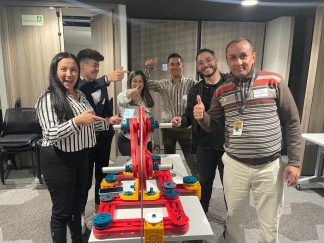How to REALLY win at the Marshmallow Challenge.
You’re about to do the Marshmallow Challenge and want to know how to win?
Or maybe you’re a facilitator looking to run the Marshmallow Challenge? In which case check out our blog post with instructions or download them right here.
The key to winning the Marshmallow Challenge is to make sure you’re aiming for the right target: think about the definition of success.
You might think that winning is simply a matter of building the tallest tower. In simple terms, yes, and it helps, but this team activity has multiple purposes, and it’s rarely used to test your tower building skills. It’s normally used to help people learn about the interpersonal processes that happen within teams, or introduce STEM and design skills. Build the biggest tower but alienate your colleagues with your dictatorial leadership style and in the long run you could end up the biggest loser.
To be effective you’ll need to excel in 3 areas: the task (design and building), team working and process (how you approach the task).
It’s tempting to start building straightaway. Resist! A robust process will help you work together as a team and implement an effective strategy. The PDCA model (Plan, Do, Check, Act) is a useful framework. Start with a PLAN: What are your ideas? What does success look like? How will you work together? Then, as soon as possible DO, implement your ideas. But, at the first opportunity stop and CHECK your structure. Is it meeting your requirements? Is it strong enough? If not how will you need to ACT differently? Successful groups tend to adopt an iterative process. They fail quickly, and learn from their mistakes.
It’s easy to follow the PDCA process by yourself, much harder in a team. If you want to be remembered as a team player then these top tips will help:
- Spend time observing and tending to the needs of your team members
- Ask questions
- Involve everyone
- Build consensus in the group by looking for, and highlighting areas of agreement
- Summarise agreements
- Encourage the team to follow a process
Now for the actual design. There are no secrets here: the Effiel Tower built in 1889, showed us the way: you can’t go to far wrong with a light lattice work of triangles.
And how to REALLY win? Make sure you reflect on the task: What did you learn about the way you work with other people? What was helping your team to function effectively? If you can apply this learning and improve your performance at school or in your organisation then no matter how tall your tower, you can say you’ve REALLY won.
If you’re thinking of running the Marshmallow Challenge then here are some powerful, professional alternatives.

